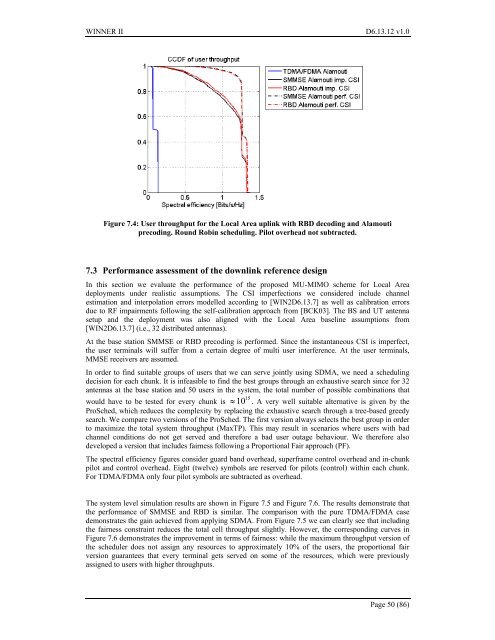IST-4-027756 WINNER II D6.13.12 v1.0 Final CG “local area ...
IST-4-027756 WINNER II D6.13.12 v1.0 Final CG “local area ...
IST-4-027756 WINNER II D6.13.12 v1.0 Final CG “local area ...
Create successful ePaper yourself
Turn your PDF publications into a flip-book with our unique Google optimized e-Paper software.
<strong>WINNER</strong> <strong>II</strong> <strong>D6.13.12</strong> <strong>v1.0</strong>Figure 7.4: User throughput for the Local Area uplink with RBD decoding and Alamoutiprecoding. Round Robin scheduling. Pilot overhead not subtracted.7.3 Performance assessment of the downlink reference designIn this section we evaluate the performance of the proposed MU-MIMO scheme for Local Areadeployments under realistic assumptions. The CSI imperfections we considered include channelestimation and interpolation errors modelled according to [WIN2D6.13.7] as well as calibration errorsdue to RF impairments following the self-calibration approach from [BCK03]. The BS and UT antennasetup and the deployment was also aligned with the Local Area baseline assumptions from[WIN2D6.13.7] (i.e., 32 distributed antennas).At the base station SMMSE or RBD precoding is performed. Since the instantaneous CSI is imperfect,the user terminals will suffer from a certain degree of multi user interference. At the user terminals,MMSE receivers are assumed.In order to find suitable groups of users that we can serve jointly using SDMA, we need a schedulingdecision for each chunk. It is infeasible to find the best groups through an exhaustive search since for 32antennas at the base station and 50 users in the system, the total number of possible combinations that15would have to be tested for every chunk is ≈ 10 . A very well suitable alternative is given by theProSched, which reduces the complexity by replacing the exhaustive search through a tree-based greedysearch. We compare two versions of the ProSched. The first version always selects the best group in orderto maximize the total system throughput (MaxTP). This may result in scenarios where users with badchannel conditions do not get served and therefore a bad user outage behaviour. We therefore alsodeveloped a version that includes fairness following a Proportional Fair approach (PF).The spectral efficiency figures consider guard band overhead, superframe control overhead and in-chunkpilot and control overhead. Eight (twelve) symbols are reserved for pilots (control) within each chunk.For TDMA/FDMA only four pilot symbols are subtracted as overhead.The system level simulation results are shown in Figure 7.5 and Figure 7.6. The results demonstrate thatthe performance of SMMSE and RBD is similar. The comparison with the pure TDMA/FDMA casedemonstrates the gain achieved from applying SDMA. From Figure 7.5 we can clearly see that includingthe fairness constraint reduces the total cell throughput slightly. However, the corresponding curves inFigure 7.6 demonstrates the improvement in terms of fairness: while the maximum throughput version ofthe scheduler does not assign any resources to approximately 10% of the users, the proportional fairversion guarantees that every terminal gets served on some of the resources, which were previouslyassigned to users with higher throughputs.Page 50 (86)
















